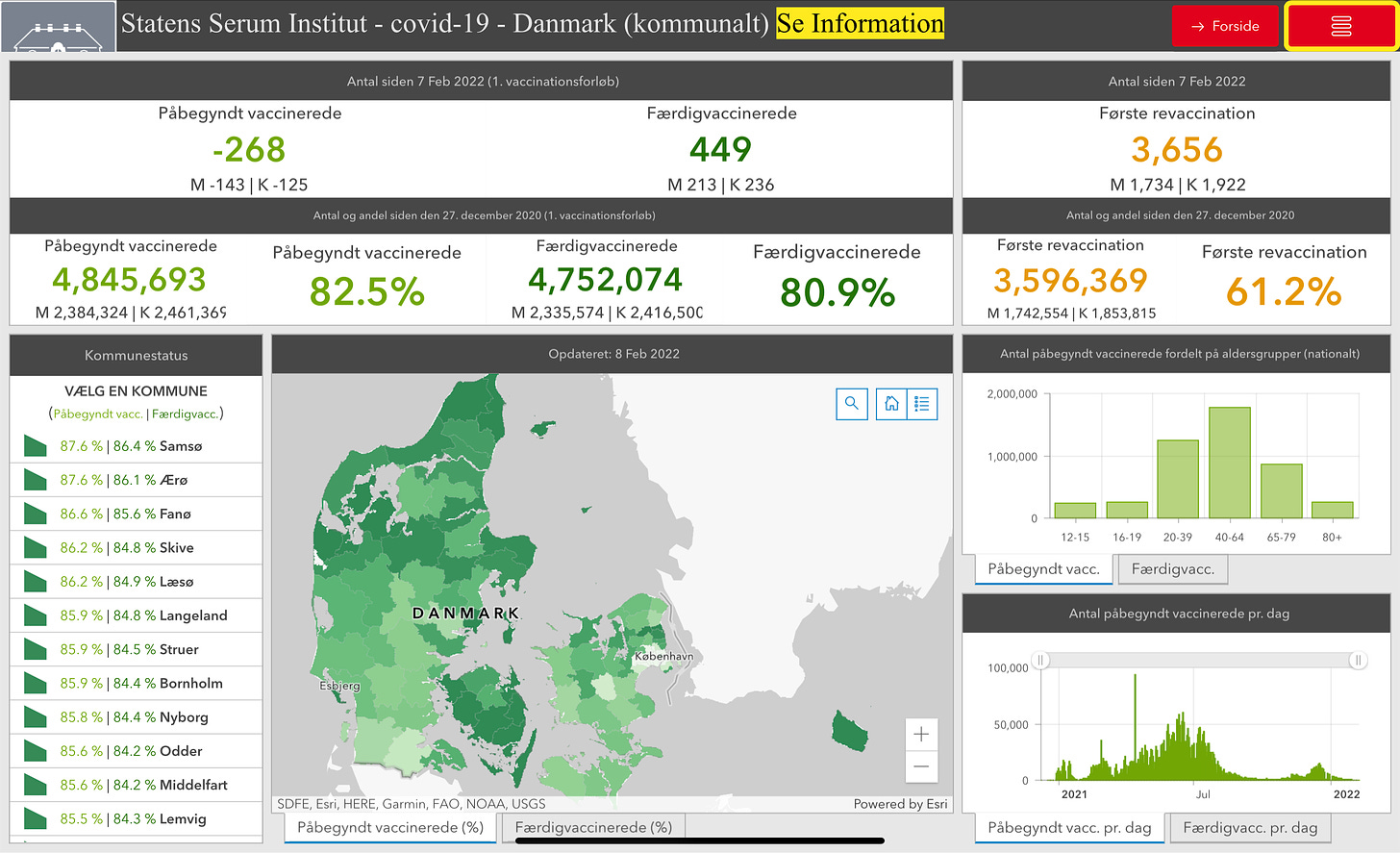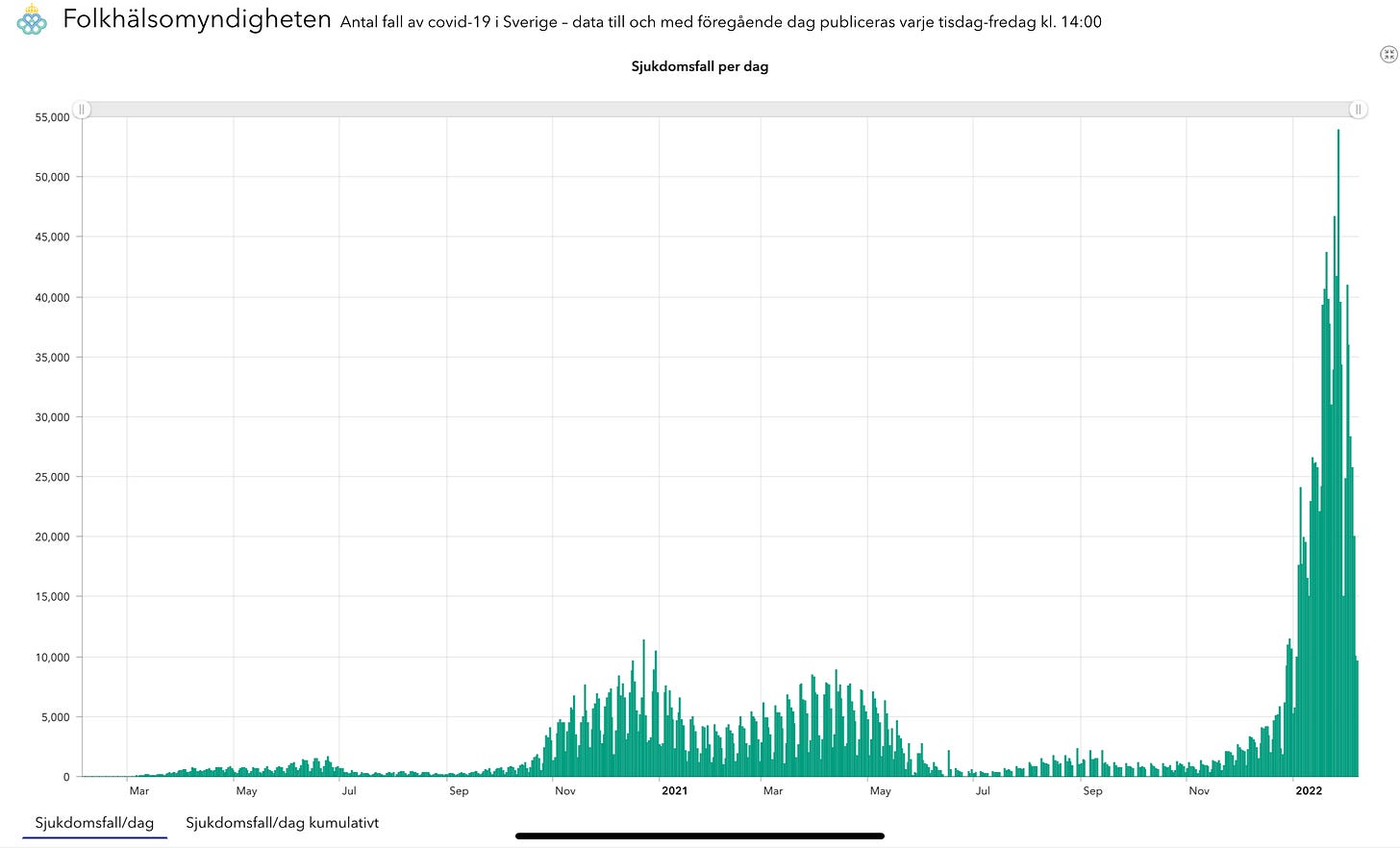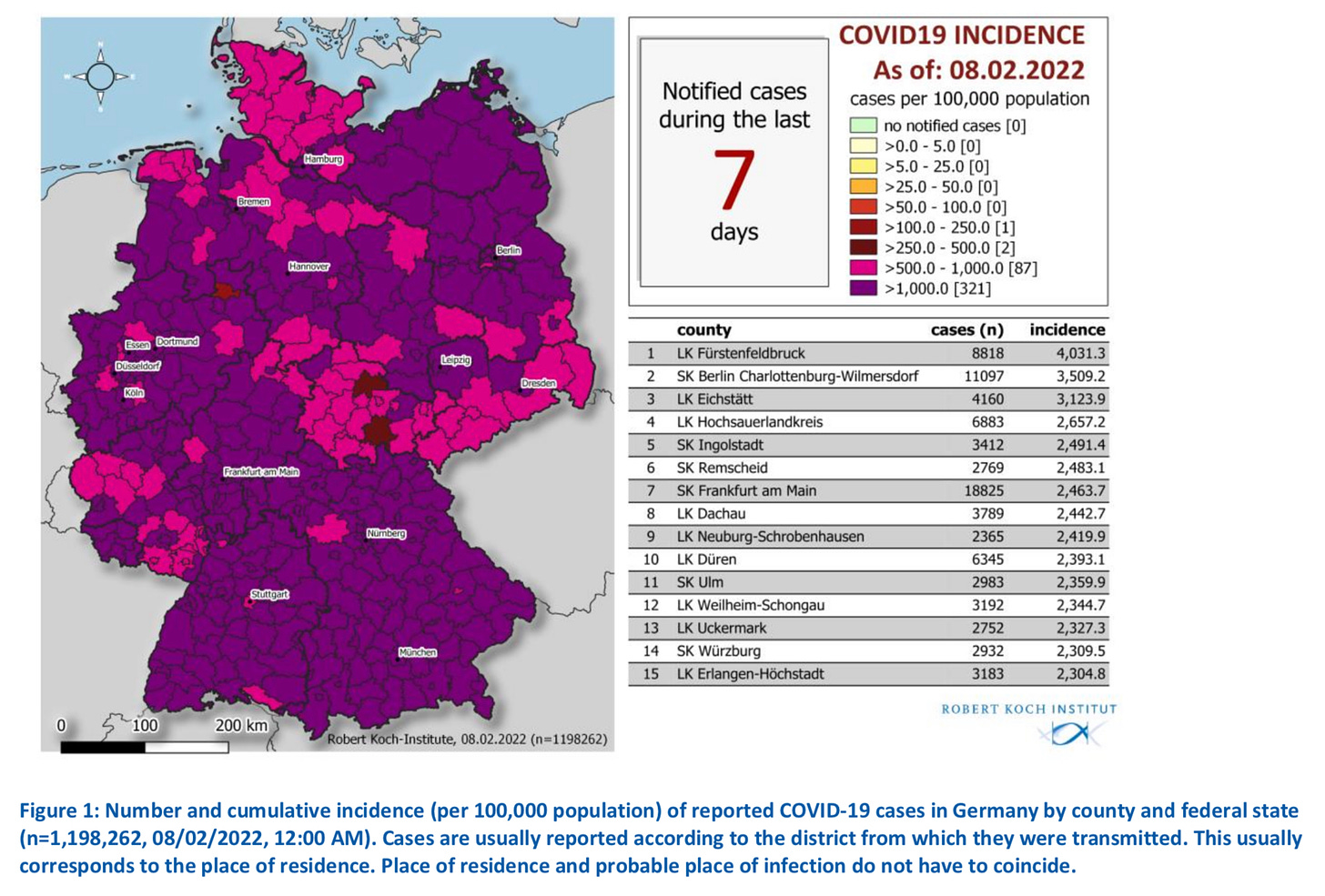🇩🇰
The Danish government is turning its attention to a serious backlog of treatments and surgeries accrued during COVID infection waves, and the nurses strike. Health Minister Magnus Heunicke estimates that by the end of February there will be about 100,000 backlogged surgeries. Heunicke has invited the five Danish regions to discussions with his office and the Minister of Finance to find ways to tackle the glut of backlogged procedures.
Health Minister Magnus Heunicke:
“The health care system has been hit hard for the last two years, especially with three coronavirus waves. While the health service has maintained the treatment of acute and life-threatening diseases. Many have had their operations postponed and are experiencing longer waiting times. Although it is not a life-threatening operation, it can be a great inconvenience to the individual. For them, it is absolutely crucial that we start reducing waiting times as soon as the pressure from COVID eases in the hospitals. That is why the Minister of Finance and I are now inviting the regions to discussions to agree on how we can get the treatment backlog settled as soon as possible.”
Discussions will begin later this week.
The Danish ministry says about 65% of the backlogged surgeries are things like knee and hip surgeries, hernia procedures, and skin removal due to weight loss. The Danish regions estimate planned medical activities to continue to be reduced or postponed by about 15 to 25%. The largest reductions have been seen in Regions Syddanmark and Region Hovedstaden.
The infection waves and especially the drawn-out labour dispute with nurses led to serious staffing shortages and caused the surgical backlog to build and build. The health ministry emphasizes critical procedures like cancer treatments and other acute interventions have continued uninterrupted.
-
As of this week, the testing regime will begin to be scaled back with rapid testing capacity being reduced from 500,000 a day down to 200,000. This is ahead of all rapid testing sites in the country being closed by March 6. The ministry of health says the addition of millions of COVID self-testing kits has reduced the need for rapid tests.
-
Despite soaring hospitalizations and very high daily infection numbers, Denmark continues to wind down its pandemic response. The Danish Agency for Patient Safety, which recently scaled back its contact tracing efforts, has now laid off about a third of the 1,800 people it hired to help with the pandemic response; many of those who manned the phones to help with contact tracing.
-
The COVID contact number (reinfection rate or R0) remains at 1.0 for a second straight week, according to Denmark’s health minister. Magnus Heunicke says while the epidemic remains stable nationally at the regional level infections are falling in the eastern part of the country, especially in Metro Copenhagen, while they rise in the three western Danish regions.
But, Heunicke cautions, the infection numbers are now “uncertain “ due to self-testing kits and decreasing overall testing. He says wastewater testing is a more reliable epidemic barometer and it also shows declining infection activity in Region Hovedstaden and Region Sjælland.
The graph below shows wastewater sampling trends in all five Danish regions.
-
Denmark is reporting 49,798 COVID infections, incl 2,759 reinfections, and 18 more coronavirus deaths in the last day.
Yesterday, there were 278,458 total corona tests done, of which 156,693 were PCR tests equaling a positivity percentage of a record-high 31.78%.
-
There is just one kommune out of Denmark’s 98 municipalities that has a COVID incidence rate of under 2,000 per 100,000 residents. Currently, there are 13 kommunes with an incidence rate of over 6,000. All of them are in Jutland.
-
On the vaccination front, the campaign continues to inch along with 3,656 booster doses administered yesterday, while 1st and 2nd doses have been reduced to a crawl.
To date, 82.5% of the total population has one dose, 80.9% have two, and 61.2% have a booster shot.
-
The head of the HOPE project and advisor to the Danish government on public attitudes during the COVID pandemic is warning that the end of the epidemic will not come easily. Political Science Professor Michael Bang Petersen says communication is key in conveying to the public how they will deal with “pandemic trade-offs” in order to help ease populations out of the pandemic.
“The key ingredients of an effective pandemic response communication, trust and a shared sense of threat are slowly dwindling. This can lead to social strife and will make it harder for leaders to steer their populations out of the crisis. The longer it takes for the realization that the risk from COVID is lowering, the longer the crisis will last and the deeper the divides it will create. Should new variants turn the presumed end, at least for Denmark, into a brief pause, such cleavages will make the next round with the virus even more difficult.
Petersen says even in Denmark, with its towering levels of social trust, that public faith in authorities has taken a hit as “as fatigue, personal costs and miscommunications have accumulated.”
“The public has become wary. Until recently, the people losing the most trust have been those who felt that their governments’ responses were too heavy-handed. However, according to our data, the Omicron wave has also chipped away at the trust of those who have been supportive of their government’s approach up until now. Lifting restrictions, while cases are soaring, can seem like betrayal after two years of seeking to flatten the curve.”
Petersen has been making the media rounds trying to explain Denmark’s decision to lift all restrictions to the rest of the world.
He has appeared in ‘The Atlantic’ which you can read HERE.
Or you can read his Op-Ed in The NY Times HERE.
🇸🇪
Sweden has added 66,670 infections and another 64 corona deaths since its last update on Friday. Reminder: Cases in Sweden are underreported as overwhelmed testing is prioritized to certain groups.
So far, 86.6% of the population 12years old and older have one vaccine dose, 83.8% have two doses, and of those 18 years old and older 53.1% have a booster shot.
-
Beginning Wednesday, most people in Sweden, even if they have COVID symptoms, will no longer be able to get a coronavirus test. The Swedish Public Health Agency is restricting testing to a very select group of people.
As of February 9, only seniors in care and patients in hospitals who have symptoms will be able to have a COVID test. The ability to order a home COVID test ended on Sunday and Monday was the last day people could schedule testing at drive-in sites, in pharmacies, and at pick-up locations. It was also the last day mobile testing sites would operate.
Region Stockholm Infection Control Doctor Maria Rotzén Östlund:
“As the general public will not be tested from this week, we must rely on other indicators to see how the spread of infection is developing. For example, we will week by week compare the positivity percentage from those who are hospitals and seniors care who have been tested and how the virus levels are in wastewater, which is followed closely by researchers.”
People are advised to stay home if they are sick and avoid close contact with other people. People who are unvaccinated are to take “special precautions” and avoid crowds.
Östlund says the focus will shift from coronavirus testing to vaccination.
“To be fully vaccinated is to take all the vaccinations against COVID that are offered. Even if restrictions and recommendations are now changed and removed, infections continue to be very high. That is why it is so important that as many people as possible get vaccinated including with a booster dose.”
-
Sweden will drop all entry restrictions for travelers arriving from its Nordic neighbours and the broader European Union and European Economic Area as of Wednesday. Per the release from Swedish authorities.
“The abolished entry restrictions mean a great relief for many travelers, not least for those who live and work in the Nordic border regions. Today's decision also means a reduced burden for the Police Authority, which no longer needs to set aside personnel to check COVID evidence at the border.”
However, while Sweden lifts entry restrictions for European travelers entry rules remain in place for anyone coming into the country from outside the EU. They will remain in place until at least March 31.
-
Hospitals in Sweden’s capital region continue to strain as COVID admissions continue to grow. As of Tuesday, there were 652 infected people in hospital, an increase of eight in the last 24 hours. Region Stockholm has 108 staffed available care beds, an increase of 13 in the last day.
Chief Physician Johan Bratt:
“652 patients with COVID place very high demands on the region’s emergency hospitals. We hope that this number will decrease as soon as possible so that care can to a greater extent resume to perform even procedures and surgeries that have been postponed during the pandemic.”
There were 3,923 COVID tests taken on Monday in Region Stockholm, with 1,990 coming back positive for a positivity percentage of a whopping 50.72%.
In the last seven days, there have been 77 more pandemic deaths in the region.
🇳🇴
Norway COVID hospitalizations (317) are up slightly (+3) while the number of severely infected people in an ICU (45) is unchanged and of those on a ventilator (27) numbers crept upward (+2).
Norge added 27,473 infections and had no new pandemic deaths since yesterday.
So far, 80.1% of Norwegians 12 years old and older have one vaccine dose, 74.3% have two, and 51.7% have a booster dose.
🇫🇮
Finland has registered 7,472 infections and 2 more virus deaths since yesterday’s update.
COVID hospitalizations (659) are unchanged.
So far, 79.2% of the total population have one vaccine dose, 74.8% have two, and 47.3% have a booster.
-
The Omicron sub-variant BA.2 is spreading rapidly in Finland. The Helsinki and Uusimaa Hospital District currently estimates the variant accounts for about one in every ten coronavirus infections.
Director of Diagnostics Lasse Lehtonen spoke to YLE:
“The BA.2 variant may be the main variant in the HUS area within one month.”
Lehtonen says the arrival of the BA.2 variant will likely prolong Finland’s current infection wave, but he doesn’t think it will threaten to overwhelm hospitals.
“At HUS, the situation has further improved compared to last week. There are now 10 COVID patients in intensive care units, which is more than half as much as in mid-January. Of course, the BA.2 variant could mean that ICU units are not cleared as quickly as we would like.”
🇩🇪
Germany reported 169,571 infections and another 177 pandemic deaths in the last day.
It added 1,518 new COVID hospitalizations yesterday while ICU numbers (2,375) increased (+25). Severely infected coronavirus cases now take up 10.6% of all adult intensive care beds in the country.
So far, 76% of Germans have one vaccine dose, 74.5% have two doses, and 54.5% have a booster dose.
🇪🇸
Spain has made it official, and this week it will lift its mandate that masks be worn outside. As of Thursday, people in Spain need only wear a face-mask on public transport and going into places like grocery stores and restaurants.
🇵🇱
Poland is backing away from its mandate that all teachers, police officers, doctors, and Armed Forces personnel be vaccinated by March 1. The Polish Ministry of Health is now admitting that the goal it set late last year will not be reached by the March deadline. It has postponed the requirement “indefinitely.”
Mandatory vaccination requirements remain in Poland for all healthcare workers. Just 57.9% of people in Poland are vaccinated with two doses. The country is experiencing its most severe infection wave yet as the Omicron variant steamrolls through the population.
🇪🇺💉
The European Medicines Agency has received an application from Pfizer/BioNTech asking for its COVID vaccine to be approved for use as booster doses for adolescents aged 12 to 15 years old. The EU pharmaceutical watchdog is already reviewing a similar application for approval for use as booster doses for older adolescents aged 16 to 17 years old.
The EMA’s says its human medicines committee will carry out an “accelerated assessment” of the new application and will render an outcome “in due course.”
🇨🇦
Canada’s Governor General Mary Simon says her husband Whit has tested positive and is isolating with mild symptoms. Simon says she has tested negative but will also isolate and self-monitor per public health guidelines.
“We are both so grateful to have been fully vaccinated and boosted, giving us the protection needed to fight off the worst of this virus.”
-
Saskatchewan will remove its proof of vaccination mandates as of February 14 and has also announced plans to scrap masking requirements by the end of the month.
-
Quebec Premier François Legault has announced that COVID restrictions will be phased out beginning this Saturday, with all restrictions lifted by mid-March.
-
Alberta will begin phasing out COVID restrictions as of midnight Tuesday with proof of vaccination mandates being scrapped. Further easing of restrictions is tied to hospitalization numbers.
-
In Canada, pandemic hospitalizations seem to be easing. The total number of care beds used for COVID-infected patients decreased from 11,022 to 9,943 between January 24 to January 31, a decline of 1,079. Of those general coronavirus admissions 8,800) dropped (-989). While the number of severely infected people in an ICU (1,143) also fell (-90) and of those the number of people on a ventilator (595) was down as well (-43).
The national positivity percentage over the last seven days is 16.4%.
Canada reported 7,877 infections on Monday while suffering the loss of another 126 lives to coronavirus. Just a reminder due to testing systems across the country being overwhelmed, daily case numbers are likely very underreported.
-
The Canadian vaccination effort has so far administered 32,073,112 1st vaccine doses (83.88% of the total population) while 30,434,737 people (79.60%) have two doses, and of those, 16,471,137 have been fully vaccinated with three doses.
In Ontario, COVID hospitalizations (2,254) have increased (+99) while the number of severe infections in intensive care (474) declined (-12). Another 42 pandemic deaths were reported on Tuesday. The province has a positivity percentage of 13.25%
Quebec saw hospitalizations (2,380) drop (-45) while the number of severe infections in an ICU (178) was unchanged. There were 56 more corona deaths. The province has a positivity percentage of 12.92%.
Newfoundland and Labrador has 23 COVID patients in hospital while adding another two deaths on Tuesday. The province has a positivity percentage of 28%.
In Nova Scotia hospitalizations (91) are down (-9) while there are 14 people in intensive care. The province has a positivity percentage of 11%.
New Brunswick saw hospitalizations (151) tread water while ICU numbers (17) crept upward (+1) and of those there were eight people on a ventilator. The province reported six more pandemic deaths on Tuesday.
Manitoba added two more corona deaths. COVID hospitalizations (697) dipped a little (-5) while the number of infected people in an ICU (40) also dropped (-7). The province has a positivity percentage of 27.3%.
Saskatchewan has ended its COVId dashboard and only reports pandemic data once a week on Thursdays.
Alberta has a positivity percentage of 36%. It reported another 39 deaths on Monday. COVID hospitalizations (1,683) are up (+81) while the number of people in an ICU (128) has also jumped (+11).
B.C. saw COVID hospitalizations (986) edge slightly downward (-1) while the number of people with severe infections in an ICU (146) crept upward (+5). There have been no new pandemic deaths in the last day. The province has a positivity percentage of 11.28%.
















